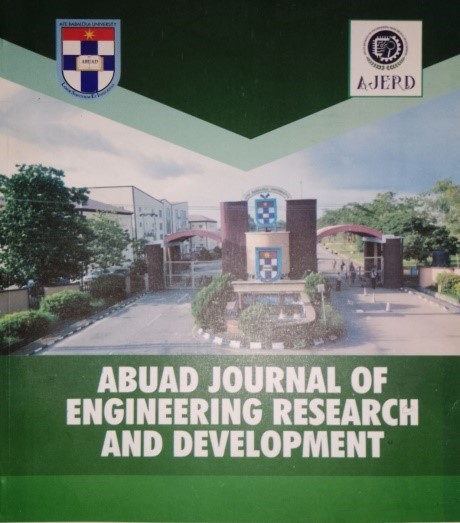Investigation of Flexural Strength of African Copalwood (Daniella Oliveri) as Reinforcement in Concrete Slab
Main Article Content
Abstract
This study investigates the potential of African Copalwood as a reinforcing material in concrete slabs. The timber rods were randomly selected from the timber market because there is always variation in timber properties with position in stem, location and soil condition. Various test specimen were prepared according to the Code of practices BS EN 408:2003 using structural size specimens. Thirty (30) slabs of size 75 mm x 300 mm x 700 mm were cast in five sets (1 to 4%) for Timber-reinforced concrete slab (TRCS) and Steel-reinforced slab (SRS) with a mix ratio of 0.5:1:2:4 denoting water-cement ratio, cement, fine and coarse aggregate respectively. Longitudinal bars were varied in 1% to 4% slab cross-sectional area in different TRCS samples while the transverse bar was restricted to be 3% by standard and made constant in all the slab samples specimen. A 10 mm diameter steel bar is used as reinforcement in the SRS. Findings revealed that the mean failure stress for Tensile strength parallel to grain was 41.80 N/mm2, Bending strength parallel to grain was 37.05 N/mm2, Compression parallel to grain was 13.48 N/mm2, Compression perpendicular to grain was 8.88 N/mm2, Local Modulus of Elasticity (MOE) was 3800.17 N/mm2, Apparent MOE was 59.42 N/mm2. Also, with regards to TRCS, the flexural strength test at 28 days for 1% to 4% reinforcement in concrete slabs is 3.61, 5.29, 5.49 and 7.22 N/mm2 respectively. The SRS has a flexural strength of 11.54 N/mm2 at 87.5% composition in slabs. These findings indicate enhancement in the strength properties of the concrete slabs with the incorporation of the African Copalwood reinforcement.
Downloads
Article Details
References
Oh, J., Pang, K., Ahn, K. & Oh, K. (2023). A Structural-Member Level Assessment of the Environmental Impact of Timber-Reinforced Concrete and Steel in Building Construction. World Conference on Timber Engineering, 2(1), 989-994. https://doi.org/10.52202/069179-0135 DOI: https://doi.org/10.52202/069179-0135
Alvaro R. E., Francisco, D.B., Raphael, K. & Itziar, A.U. (2018). Evaluation of the Bond-to-Concrete Properties of GFRP Rebars in Marine Environments. Journal of Infrastructure. (44), 1-10. https://doi: 10.3390/infrastructures3040044 DOI: https://doi.org/10.3390/infrastructures3040044
Acikel, H. (2019). Mechanical Properties of Hybrid Fibre Reinforced Concrete and a Non-Destructive Evaluation. Material Testing. (61)12, 1171-1177. https://doi.org/10.3139/120.111438 DOI: https://doi.org/10.3139/120.111438
Grazide, C., Emmanuel, F. & Laurent, M. (2019). Rehabilitation of Reinforced Concrete Structures Using FRP and Wood. Construction and Building Material Journal. https://doi.org/10.1016/j.conbuildmat.2019.117716 DOI: https://doi.org/10.1016/j.conbuildmat.2019.117716
Mohammed, T.O. (2023). Investigation on the Uses of Rice Husk Ash-Cement Concrete Reinforced with Oil Palm Broom Fibre. M.Eng Thesis, Civil Engineering Department, University of Ilorin, Ilorin.
Schneider, N., Pang, W. & Gu, W. (2014). Application of Bamboo for Flexural and Shear Reinforcement in Concrete Beams. Structure Congress, ASCE, 4(2), 1024-1034. https://doi.org/10.1061/9780784413357.091 DOI: https://doi.org/10.1061/9780784413357.091
Mohammad, A.Z., &, Nurul, J.M. (2015). Application of Flexural Timber Reinforcement in Light Concrete Beam Structure. Applied Mechanics and Materials, (695), 631-634. https://doi.org/10.4028/www.scientific.net/AMM.695.631 DOI: https://doi.org/10.4028/www.scientific.net/AMM.695.631
Bello, M., Jimoh, A.A. (2018). Study on the Behaviour of Africa Birch Timber as Reinforcement in Concrete. Journal of Applied Science and Environmental Management, (22) 1, 79-84. https://dx.doi.org/10.4314/jasem.v22i1.14 DOI: https://doi.org/10.4314/jasem.v22i1.14
Ezeagu, C.A., Ethelbert, M., Onyebuchi, J.A. (2021). Assessment of the Suitability of Timber Product as Concrete Reinforcement Bar in Green Buildings, Nigeria Research Journal of Engineering and Environmental Science, 6(2), 753- 763. https://doi.org/10.5281/tjet.v42i3.742
Mankuza, J.K. (2023). Application of Mangrove Timber in Reinforcing Concrete, Tanzania Journal of Engineering and Technology, 42(3), 16-24. https://doi.org/10.52339/zenodo.5805386 DOI: https://doi.org/10.52339/tjet.v42i3.742
British Standard Institution (1957) BS 373:1957. Methods of Testing Small Clear Specimens of Timber. British Standard Institution, London, United Kingdom.
British Standard Institution (1990) BS 812:1990. Methods of Testing Small Clear Specimens of Timber. British Standard Institution, London, United Kingdom
British Standard Institution (1995) BS 812:1995. Methods of Testing Aggregates. British Standard Institution, London, United Kingdom
British Standard Institution (1995) BS 812:1985. Methods of Testing Aggregates of Timber. British Standard Institution, London, United Kingdom
British Standard Institution (2003) BS 408:2003. Structural and Glue Laminated Timber. British Standard Institution, London, United Kingdom
British Standard Institution (2021) BS 12390-1:2021. Testing of Hardened Concrete. British Standard Institution, London, United Kingdom.
British Standard Institution (1997) BS 8110:1997. Structural Use of Concrete Design and Construction. British Standard Institution, London, United Kingdom




